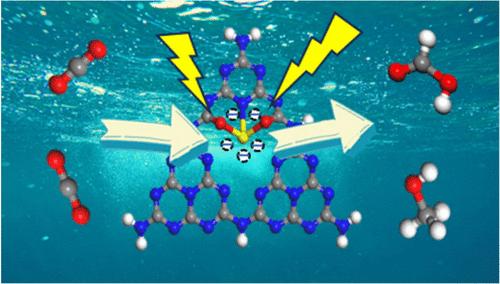Transition Metals Doped into g-C3N4 via N,O Coordination as Efficient Electrocatalysts for the Carbon Dioxide Reduction Reaction
IF 3.7
2区 化学
Q2 CHEMISTRY, MULTIDISCIPLINARY
引用次数: 0
Abstract
The electrochemical carbon dioxide reduction reaction (CO2RR) is a potential and efficient method that can directly convert CO2 into high-value-added chemicals under mild conditions. Owing to the exceptionally high activation barriers of CO2, catalysts play a pivotal role in CO2RR. In this study, the transition metal (TM = Sc, Ti, V, Cr, Mn, Fe, Co, Ni, Cu, and Zn) is doped into g-C3N4 with a unique N,O-coordination environment, namely, TM–N1O2/g-C3N4. Herein, the catalytic performance and reaction mechanism for the CO2RR on TM–N1O2/g-C3N4 are systematically investigated by density functional theory methods. Especially, through the calculation of ΔG*H and ΔG*COOH/ΔG*OCHO, the catalysts with preference for the CO2RR over the hydrogen evolution reaction (HER) are selected for further study. Furthermore, Gibbs free energy computation results of each elementary step for the CO2RR on these catalysts indicate that Ti–N1O2/g-C3N4 has significant catalytic activity and selectivity for reducing CO2 to methanol (CH3OH) with the limiting potential (UL) of −0.55 V. Finally, through frontier molecular orbital theory and charge transfer analyses, the introduction of the O atoms illustrates that it is instrumental in regulating the electron distribution of the catalytic active site, thereby improving the catalytic performance. This work provides insight into the design of single-atom catalysts with unique coordination structures for the CO2RR.

通过 N、O 配位掺入 g-C3N4 的过渡金属作为二氧化碳还原反应的高效电催化剂
电化学二氧化碳还原反应(CO2RR)是一种潜在的高效方法,可在温和条件下直接将二氧化碳转化为高附加值化学品。由于 CO2 的活化势垒极高,催化剂在 CO2RR 中起着举足轻重的作用。本研究将过渡金属(TM = Sc、Ti、V、Cr、Mn、Fe、Co、Ni、Cu 和 Zn)掺杂到具有独特 N、O 配位环境的 g-C3N4 中,即 TM-N1O2/g-C3N4。本文采用密度泛函理论方法系统地研究了 TM-N1O2/g-C3N4 上 CO2RR 的催化性能和反应机理。特别是通过计算ΔG*H 和 ΔG*COOH/ΔG*OCHO,筛选出 CO2RR 比氢气进化反应(HER)更优先的催化剂,以作进一步研究。此外,这些催化剂上 CO2RR 各基本步骤的吉布斯自由能计算结果表明,Ti-N1O2/g-C3N4 在将 CO2 还原为甲醇(CH3OH)时具有显著的催化活性和选择性,极限电位(UL)为 -0.55 V。最后,通过前沿分子轨道理论和电荷转移分析,O 原子的引入说明它有助于调节催化活性位点的电子分布,从而改善催化性能。这项研究为设计具有独特配位结构的 CO2RR 单原子催化剂提供了启示。
本文章由计算机程序翻译,如有差异,请以英文原文为准。
求助全文
约1分钟内获得全文
求助全文
来源期刊

Langmuir
化学-材料科学:综合
CiteScore
6.50
自引率
10.30%
发文量
1464
审稿时长
2.1 months
期刊介绍:
Langmuir is an interdisciplinary journal publishing articles in the following subject categories:
Colloids: surfactants and self-assembly, dispersions, emulsions, foams
Interfaces: adsorption, reactions, films, forces
Biological Interfaces: biocolloids, biomolecular and biomimetic materials
Materials: nano- and mesostructured materials, polymers, gels, liquid crystals
Electrochemistry: interfacial charge transfer, charge transport, electrocatalysis, electrokinetic phenomena, bioelectrochemistry
Devices and Applications: sensors, fluidics, patterning, catalysis, photonic crystals
However, when high-impact, original work is submitted that does not fit within the above categories, decisions to accept or decline such papers will be based on one criteria: What Would Irving Do?
Langmuir ranks #2 in citations out of 136 journals in the category of Physical Chemistry with 113,157 total citations. The journal received an Impact Factor of 4.384*.
This journal is also indexed in the categories of Materials Science (ranked #1) and Multidisciplinary Chemistry (ranked #5).
 求助内容:
求助内容: 应助结果提醒方式:
应助结果提醒方式:


